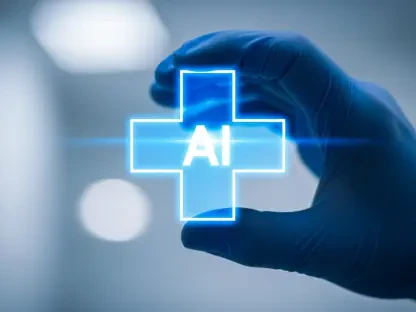Imagine a world where a single scan can predict a life-threatening condition years before symptoms appear, or where hospital staff shortages are seamlessly managed by intelligent systems, ensuring no patient is left waiting. This is not a distant dream but the reality unfolding in healthcare today, driven by the power of artificial intelligence (AI). As the industry grapples with rising costs, clinician burnout, and an ever-growing demand for precision, AI emerges as a transformative force, promising to reshape diagnostics, operations, and patient care. This review dives deep into the capabilities of AI in healthcare, exploring its key applications, real-world impact, and the challenges that must be navigated to unlock its full potential.
Understanding AI’s Role in Modern Healthcare
AI in healthcare encompasses a range of technologies, from machine learning algorithms to natural language processing, designed to mimic human cognition and enhance decision-making. These tools analyze vast datasets, recognize patterns, and provide actionable insights, addressing critical needs such as diagnostic accuracy and operational efficiency. The rise of AI responds directly to systemic pressures, including aging populations and limited resources, positioning it as a vital ally in overcoming longstanding barriers.
The significance of AI extends beyond individual tools to its integration within the broader technological ecosystem of healthcare. By connecting with electronic health records (EHRs) and other digital platforms, AI ensures a cohesive approach to data management, enabling real-time solutions. This synergy highlights AI’s potential to not only solve immediate problems but also lay the groundwork for a more adaptive and responsive medical landscape.
Key Applications Driving Change
Intelligent Medical Imaging and Diagnostics
AI’s prowess in medical imaging is redefining diagnostics, particularly in specialties like radiology and pathology. By scrutinizing X-rays, MRIs, and other scans, AI algorithms detect subtle anomalies—such as early-stage tumors—that might escape human observation, facilitating timely interventions. This precision significantly reduces diagnostic errors, bolstering physician confidence in high-stakes decisions.
Integration with systems like picture archiving and communication systems (PACS) ensures that AI insights are readily accessible within clinical workflows. Such connectivity streamlines processes, allowing radiologists to focus on complex cases rather than routine assessments. The result is a marked improvement in patient outcomes, as conditions are identified and treated at earlier, more manageable stages.
Beyond error reduction, AI in diagnostics fosters a collaborative dynamic between technology and clinicians. While the final call remains with medical professionals, the supportive role of AI enhances their ability to interpret data, ensuring that technology amplifies rather than replaces human expertise. This balance is crucial for maintaining trust in automated systems.
Predictive Analytics for Patient Risk Assessment
Another transformative application lies in AI-driven predictive analytics, which forecasts patient risks by analyzing historical and real-time data. These models identify potential complications or readmissions, enabling hospitals to intervene proactively. For instance, predicting a patient’s likelihood of post-surgical infection allows for tailored monitoring and preventive measures.
Such foresight optimizes resource allocation, ensuring that staff and equipment are deployed where most needed. Hospitals benefit from reduced readmission rates, while patients experience smoother recoveries through personalized care plans. This application underscores AI’s capacity to bridge clinical foresight with operational planning, enhancing overall system efficiency.
The impact on discharge planning is equally notable, as AI helps clinicians anticipate post-hospital needs, reducing unnecessary stays. By aligning care delivery with predicted outcomes, healthcare facilities can manage capacity more effectively, addressing overcrowding and improving patient satisfaction in a measurable way.
Streamlined Staffing and Productivity Solutions
AI is also tackling the pervasive issue of staffing shortages through intelligent scheduling and productivity tools. Platforms that match clinician availability with patient demand in real-time alleviate administrative burdens, cutting down on overtime expenses. These systems ensure that shifts are filled promptly, maintaining care continuity even during peak demand.
Innovative features, such as voice-to-shift tools, allow managers to create schedules effortlessly by converting spoken instructions into actionable postings. This not only saves time but also reduces errors in shift planning, enabling facilities to respond dynamically to unexpected absences or surges in patient volume.
The ripple effect of streamlined staffing extends to cost savings and improved morale among healthcare workers. By minimizing the chaos of understaffing or overworking, AI fosters a more balanced workplace, allowing clinicians to focus on patient interaction rather than logistical challenges, thus enhancing service quality.
Clinical Documentation Automation
Generative AI is revolutionizing clinical documentation by automating the creation of patient notes through voice-to-text systems. During consultations, these tools transcribe conversations into structured records, slashing the time spent on paperwork. Clinicians can review and refine these drafts, ensuring accuracy while reclaiming hours for direct care.
Seamless integration with EHRs further enhances this application, embedding AI-generated notes directly into patient files. This connectivity eliminates redundant data entry, reducing the risk of transcription mistakes and ensuring that records remain up-to-date and accessible across departments.
The primary benefit here is the shift in focus from administrative tasks to patient engagement. Freed from the burden of extensive documentation, healthcare providers can build stronger rapport with patients, addressing their concerns more thoroughly and improving the overall care experience in clinical settings.
Agentic AI for Autonomous Operations
At the frontier of AI development, agentic systems are emerging to handle tasks independently, such as optimizing operating room schedules or managing supply chains. These tools analyze real-time data to make decisions without human input, addressing bottlenecks before they escalate. Although still in early stages, this application hints at a future of self-regulating healthcare operations.
The potential of agentic AI lies in its ability to enhance efficiency on a systemic level. For example, autonomously adjusting inventory orders based on usage patterns prevents shortages or overstocking, ensuring that resources are always aligned with demand. Such capabilities could redefine hospital management over time.
However, the nascent nature of agentic AI necessitates cautious deployment. Robust testing and oversight are essential to prevent errors in autonomous actions, as missteps in critical areas like surgery scheduling could have serious repercussions. This highlights the need for phased implementation as the technology matures.
Current Trends in AI Adoption
The momentum behind AI integration in healthcare is accelerating, fueled by the urgent need for cost-effective solutions and better patient outcomes. Hospitals and clinics are increasingly embedding AI tools into their workflows, driven by evidence of improved efficiency in both clinical and administrative domains. This trend reflects a broader shift toward digital transformation across the sector.
Emerging innovations, such as hybrid models combining AI with clinician input, are gaining traction as a way to balance automation with human oversight. This complementary approach ensures that technology supports rather than dictates care, addressing concerns about over-reliance on algorithms while maximizing their benefits.
Clinician involvement in tool selection and rollout remains a critical factor in successful adoption. Engaging frontline staff in the design and testing phases ensures that AI solutions are tailored to real-world challenges, fostering acceptance and trust. This collaborative model is shaping how healthcare facilities approach technological upgrades today.
Real-World Impact and Case Studies
AI’s tangible benefits are evident across diverse healthcare settings, from urban hospitals to rural clinics. In clinical environments, predictive analytics have enabled earlier interventions for at-risk patients, significantly lowering complication rates. Such outcomes demonstrate AI’s direct contribution to life-saving care.
Administratively, platforms leveraging AI for staffing, like those matching nurses to open shifts instantly, have transformed workforce management. These tools have cut down on agency costs and improved response times during emergencies, ensuring that patient needs are met without delay in various facilities.
Specific use cases, such as AI-assisted cancer detection, further illustrate practical impact. Algorithms trained on vast imaging datasets now flag potential malignancies with remarkable accuracy, guiding oncologists toward precise treatment plans. These examples underscore AI’s role as a game-changer in specialized care delivery.
Challenges Hindering Broader Integration
Despite its promise, AI faces significant hurdles in healthcare adoption, including skepticism from clinicians wary of algorithmic inaccuracies or privacy breaches. Concerns about bias in training data also loom large, as skewed inputs could lead to unequal care delivery, eroding trust in automated systems among providers and patients alike.
Technical and regulatory challenges add further complexity, with cybersecurity risks posing a threat to sensitive patient information. Ensuring compliance with stringent laws, such as those governing data protection, requires robust safeguards, while accountability gaps in AI decision-making demand clear frameworks to define responsibility.
Efforts to address these barriers are underway, focusing on enhanced training for staff and strategic piloting of tools in controlled settings. Establishing oversight mechanisms and fostering dialogue between developers and healthcare professionals are also key steps toward mitigating risks and building confidence in AI’s reliability over time.
Future Prospects for AI in Healthcare
Looking ahead, AI’s trajectory in healthcare points toward groundbreaking advancements, particularly with the maturation of agentic systems capable of independent operation. These could revolutionize entire workflows, from inventory management to patient triage, promising unprecedented efficiency gains across the board in coming years.
Wider adoption of predictive tools is also anticipated, potentially becoming standard in personalized medicine. As algorithms grow more sophisticated, their ability to tailor treatments to individual patient profiles could redefine care standards, driving down costs while elevating quality in diverse medical contexts.
Yet, the path forward demands a balanced approach to innovation, prioritizing patient safety and trust. Strengthening regulatory frameworks and investing in clinician education will be essential to ensure that AI’s expansion aligns with ethical standards, paving the way for sustainable progress in healthcare transformation.
Final Reflections
Reflecting on the journey of AI in healthcare, it becomes clear that this technology has already made significant strides in enhancing diagnostics, streamlining operations, and improving patient outcomes. Its ability to support clinicians through precise insights and automated tasks stands out as a defining achievement. The real-world impact, evidenced by better staffing solutions and early disease detection, highlights AI’s value as an indispensable tool.
Moving forward, stakeholders need to focus on actionable strategies to overcome lingering challenges. Prioritizing robust data security measures and fostering clinician-tech collaboration are critical next steps to ensure safe integration. Additionally, scaling successful pilot programs offers a practical roadmap for broader implementation, ensuring that AI continues to evolve as a trusted partner in medicine.









